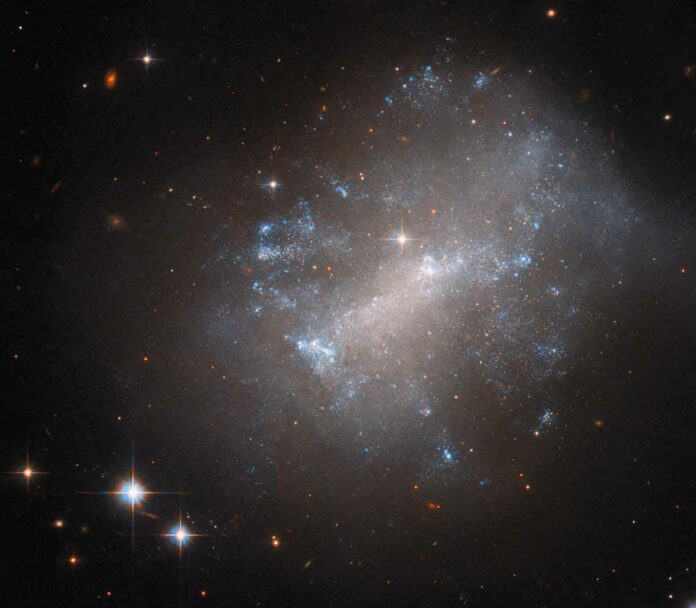NGC 7292, a captivating galaxy located 44 million light-years away in the constellation Pegasus, has fascinated astronomers with its peculiar characteristics.
As captured by the NASA/ESA Hubble Space Telescope, this irregular galaxy lacks the defined spiral arms or elliptical shape commonly associated with other galaxies.
Instead, NGC 7292 showcases a stretched-out core, forming a distinctive bar that mirrors the features found in many spiral galaxies.
Its ethereal appearance is further accentuated by its low surface brightness, making it barely distinguishable against the vast expanse of the night sky.
This unique galaxy is primarily composed of gas and dark matter, with stars playing a subordinate role.
Unveiling the Secrets of NGC 7292
In a quest to deepen our understanding of Type II supernovae and their diverse aftermaths, astronomers turned their attention to NGC 7292.
These cataclysmic events occur when a massive star undergoes a collapse, followed by an explosive rebound that tears the star apart.
The Hubble Space Telescope was directed to scrutinize “NGC 7292” as part of an observational campaign focusing on the aftermath of such supernovae.
SN 1964H: The Stellar Cataclysm
A significant supernova event, named SN 1964H, was observed within NGC 7292 in 1964.
By studying the stellar neighborhood surrounding SN 1964H, astronomers hope to unravel the mysteries of its progenitor star’s initial mass.
This information is crucial for understanding the dynamics of supernovae and the forces that drive these powerful explosions.
Furthermore, this investigation could potentially unveil any surviving stellar companions that once coexisted within the same system as the star that ultimately became SN 1964H.
Shedding Light on the Cosmos
The data obtained from the Hubble Space Telescope’s observations of NGC 7292 and its supernova provide valuable insights into the formation and evolution of galaxies.
By examining the diverse nature of supernovae and their impact on the surrounding cosmic environment, scientists can piece together the intricate puzzle of our universe’s history.
NGC 7292’s irregular nature challenges our conventional understanding of galaxy formation and structure.
Its bar-like core, absent of the typical spiral arms or elliptical shape, presents a unique case for astronomers to explore.
The galaxy’s low surface brightness further adds to its enigmatic allure, as it necessitates advanced telescopes like Hubble to unravel its secrets.
Journey into the Cosmos
Astronomers are on an ever-continuing journey to explore the depths of space and uncover the mysteries concealed within galaxies like NGC 7292.
The enigmatic features and faint appearance of this irregular galaxy have piqued the curiosity of scientists worldwide.
As our understanding of the universe expands, NGC 7292 stands as a testament to the diverse and captivating nature of the cosmos, beckoning us to delve deeper into its extraordinary realm.
In the vast expanse of the universe, galaxies like NGC 7292 serve as celestial canvases, showcasing the incredible beauty and diversity that exists beyond our planet.
The ongoing research and investigations surrounding this remarkable galaxy contribute to our collective knowledge and bring us closer to comprehending the profound wonders of the cosmos.
FAQ
NGC 7292 stands out due to its irregular shape and the presence of a stretched-out core resembling a bar. It lacks the well-defined spiral arms or elliptical shape commonly associated with other galaxies. Additionally, its low surface brightness makes it barely visible against the backdrop of the night sky.
The galaxy NGC 7292 resides in the constellation Pegasus and is situated at a distance of around 44 million light-years from Earth.
By studying SN 1964H, astronomers aim to estimate the initial mass of the star that went supernova. This information helps unravel the dynamics of supernovae and sheds light on the forces driving these cataclysmic events. Furthermore, it may reveal any surviving stellar companions that were once part of the same system.
NGC 7292 is primarily composed of gas and dark matter, with stars playing a lesser role in its overall makeup.
The Hubble Space Telescope’s observations of NGC 7292 provide valuable data for understanding the formation and evolution of galaxies. It allows scientists to explore the diverse nature of supernovae and their impact on the cosmic environment surrounding NGC 7292.
Text credit: European Space Agency (ESA)/NASA

